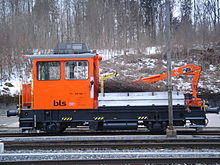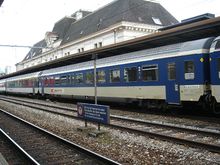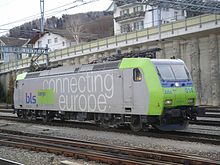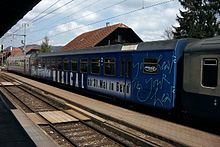BLS colors
In the past, vehicle coatings were often more a weather protection for the wood of the car body, today a corporate identity is expressed with the color scheme . This change is also visible at BLS , where strong colors were brought into play relatively early in 1935. In the course of time the following paints have been used for BLS vehicles and the vehicles of their predecessor railways:
BLS green
For a long time, green was the color of the railway and so the passenger cars of the BLS and its co-operated railways were also green. The first electric locomotives were also delivered in green in 1913, but when they were first repainted, they switched to brown. From 1947 the locomotives, especially the Ae 4/4, were painted green again; the Ee 3/3 401 shunting locomotive appeared in green as a forerunner in 1943. Even a “Blue Arrow” (731) was given a green color in 1947, but in 1949 it switched back to its more pleasing original color blue / cream. By 1959 the locomotives (171, 251–256, 302, 309, 313, 401) had their brown dress (back) again. In the case of the cars, the green was the general color for new deliveries and revisions until 1971 (A 800–805), and for the car control cars until the turn of the millennium. The BDt 942-945 were the last BLS vehicles delivered in green. In addition, some vehicles (Re 420.5, Dt) taken over or rented by SBB in 2004 and 2005 have kept their green paint for the time being. However, this green would have to be classified as SBB green .
EBT green or cream
On the previous RM railroads, passenger transport vehicles were generally green until 1968/69. Then the high-performance railcars BDe 4/4 "with the double-door EW I, the then newly delivered EW II and five BDe 4/4 '(211, 212, 241, 245, 291 and ABt 311, 312, 341) turned green / Cream coated, as it was also used by BT and SOB for the shuttle trains with the high-performance railcars. The BDe 4/4 'were broken off in this condition, the BDe 4/4 ", EW I and II received the red towards the end of the 1970s Painting. In contrast, the Re 4/4 III delivered in 1969 and 83 still appeared in green.
BLS brown
When exactly the first BLS locomotive appeared in a brown paintwork cannot be precisely clarified. But in the early 1920s, when the "decree railways" were electrified and the number of electric locomotives increased, Braun became the standard. The second delivery of the Ae 4/4 made a detour to green, probably inspired by the green Re 4/4 'of the SBB, but soon returned to the brown, which then went up to the last Re 4/4 (Re 425), the locomotive 195 delivered in 1983 was retained. These locomotives should keep their color and thus their character.
BLS blue
From 1994 to 98 the Re 465 and the first 8 NINAs were delivered. For these vehicles, a blue primer with a white dividing line and gray underneath, dark gray for the Re 465 and light gray for the NINA. While the NINA 2001/02 were the first to be overmolded in the new colors silver-green-blue, the Re 465 initially retained their blue paint. From 2020 the Re 465 will undergo a refit, the standard color changes to BLS lime green with a blue logo.
BLS red
The red color was and is only used by the BLS for shunting vehicles, the Ee 401 had been red since 1962, the Te 'since 1960–62. Of the modern vehicles, the Tea 21-24 and the Eea 402 were delivered in red. In addition, the Re 420 507 and 510 kept their red paintwork for almost two years when they were taken over by SBB (December 2005) (until August / September 2007). The tea appeared in 2007/08 in silver-green-blue.
BLS orange
For some time, orange was the color of thermal tractors (Tm), and the shunting vehicles formerly RM are also orange. Some Tm have already appeared in silver-green-blue. For a few months, the Re 420 512 also ran in its orange-stone-gray Swiss Express paint scheme from the SBB.
RM old red
With the appearance of the RBDe 4/4 ' commuter trains in 1974, the then EBT group changed to the red color with a white dividing line below. All railcars and coaches built from 1964 onwards received this paint.
RM Colani Red
The well-known designer Luigi Colani developed his own paint scheme for the two KTU locomotives VHB Re 456 142 and 143 delivered in 1993 with an oversized RM signet and a wide white stripe under the roof. The RM then adapted this paint for the RBDe 4/4 'which are due for the main revision. All intermediate wagons, the NPZ intermediate wagons "B Lego", an ABt (937 ex 962) repaired after a collision, a BD EW II (751) and the five Re 436 received this paint job.
RM neurotic
When the GTW was due for delivery and the RBDe 4/4 "(NPZ) for the main overhaul, a new design was looked for again. The ABt 940 still bears witness to this look in 2004, the associated RBDe 566 240 multiple unit was later Aligned to the definitive version. All GTW have this paint with a narrow white decorative line on top. Until the main revision of the NPZ was finished, the RM no longer existed and so the trains 232/932 and 237/937 escaped the neurotic paint.
BLS blue or cream (high)
In 1935, the BLS received the first “Blue Arrows” based on construction principles similar to those of the SBB “ Red Arrows ” delivered in the same year . In contrast to the SBB, normal couplings were attached from the start, lightweight trailers were purchased for some railcars and articulated railcars (with Jakobs frames ) were soon purchased. After ten years the development was continued with double railcars and it was not until 1964 that the last railcar, still known as the “Blue Arrow”, was delivered. These vehicles took over a substantial part of the regional traffic and shaped the image of the BLS. In 1969/70 six EW I (801-04, 880-81) were painted blue / cream and control cars appeared in these colors. Finally, in 1976/77, 7 A (806–812) and 17 B EW I (839–45, 890–99) with this paint came into operation, supplemented by three internally and externally adapted AB (813–15), which were installed in block trains in the Long-distance transport were used. Over the years the blue used had become lighter.
BLS blue or crème (deep)
With the appearance of the first new commuter trains (NPZ, RBDe 565) and the start of the main revision of the EW I, the blue-crème paintwork was slightly modified. The end of the car was now completely blue and the color separating edge was set lower. Many EW I still wear this paint today, but it disappeared from the NPZ in December 2006 after more than 71 years of use on BLS railcars.
BLS cream or blue
In 1983 the WR 451 bought from the then Bodensee-Toggenburg-Bahn (BT) (today Südostbahn ) was painted in the reverse colors of cream / blue. Already at BT he had worn a cream / green instead of green / cream paint over the last few years. This was followed by the BR 450, also from BT, and the EW I, specially prepared for the GoldenPass, now gold-colored, EW I. In 1987, the first EW IV came into operation and these had exactly the same color scheme as the SBB wagons, but in BLS colors . The front sides were no longer blue as on the EW I, but the colored edge ran at the same height around the car. After the sale to the SBB in December 2004, the wagons were still used in these colors for some time, but with the SBB logo in commuter trains, especially in Valais. The type EW I baggage trolleys were also given a matching paint, but were soon replaced by D ex SNCF. The A 837 is the only car with a cream / blue paint job that is still in operation. When the new logo was applied, the inscription “Salon Bleu” was removed.
BLS silver green blue (silver lime green blue)
After the decision to hand over long-distance passenger transport to SBB and to take over the Bern S-Bahn and RE (then RX) Bern - Lucerne and (since December 2007) Bern - Brig from the SBB, the appearance that was up to then also changed based on the brand BLS Lötschbergbahn , redefined. In addition to the traditional blue, there should be a lime green and both should be used together on a silver-gray background. The brand should only be BLS alone, the decision was made to use lowercase letters, i.e. bls . With the merger with Regionalverkehr Mittelland , which further strengthened the regional traffic segment, the company name under commercial law was also shortened to BLS AG . For fun's sake it is now claimed that BLS stands for blue-lime-green-silver.
The color implementation began in mid-2001. On the occasion of the centenary of the Bern-Neuchâtel railway, the freshly molded NINA 01 was presented. In 2003 the first NPZ (RBDe 565 728-ABt 985) appeared in the new colors. By December 2004, all EW IIIs that were taken over by SBB at this point in time (or exchanged for EW IV) were also overmolded in the new BLS colors. Gradually, other vehicle types and all newly delivered vehicles appeared in silver-green-blue. In mid-2006, the lettering bls was slightly changed and the former RM logo, a stylized impeller, was added.
In newer vehicles such as the Re 485 or the Lötschberg RABe 535 , the blue components have been further reduced
BLS umbra gray green (car transport)
The control cars of the car transport were the last representatives of the classic green color. The BDt 946-949, converted from Bt 970 ... 91 in 2001/03, retained their old blue / cream paint. On the other hand, the BDt 939, which was completed in mid-2005 from the conversion of an SBB EW I DZt, appeared in an umbra-gray paint (RAL 7022) with a green front and blue numbers and logo. In March 2007 the BDt 947 also appeared in this style.
BLS special paints and advertising paints
At BLS there were special paints for individual vehicle series early on, nowadays there are also advertising paints on their own behalf or for cultural institutions and events.
| The first three electric multiple units Ce 4/4 781–83 came into operation in 1910 in a wine-red paint scheme. | ||
| The CFe 4/5 (later De 4/5 791-796) appeared in 1929 in a wine-red / gray paint, in 1936 the three railcars 781-83 followed. | ||
| The Ce 4/4 761-62 appeared in 1953 in blue-green, the Be 4/4 763 delivered in 1956 came in a light green / dark green paint and the other two railcars followed in 1958, but the switch to car green was made in 1962/63. The Be 4/4 761, which has been preserved as a historic vehicle, has again been painted in light green / dark green. | ||
| The A 826–827, B 828–829, the WR 451 (broken off in 2007) as well as the AB 801 and the BDt 940, which were specially set up for the GoldenPass train, were given a golden coat of paint of the same kind in 2001 as on the Montreux-Bernese trains Oberland-Bahn and Brünigbahn , new Zentralbahn , are common. | ||
| For the annual Thuner Seefestspiele (performance of an open-air musical) the Re 465 003 is put into a suitable dress. | ||
| In 2001 an NPZ intermediate car “Lego” was given a special dark blue paint to advertise a musical. | ||
| Other Re 465 advertise or advertise for their own purposes, e.g. B. Re 465 001 for BLS Alp Transit, the company that built the Lötschberg base tunnel (and subsidiary of BLS AG ). | ||
| Various leased 185s, which technically correspond to their own Re 485s, came in the blue or blue-green of the rental company. The blue-green locomotives have the new BLS Cargo logo with the same letters as the BLS itself (the b is no longer open at the top), but without the impeller that was taken over from RM, but with the previous "cargo" logo. | ||
| The BDt EW II 911–915 taken over by the SBB retained the SBB regional traffic paint or hummingbird paint light gray / blue with yellow doors after the takeover. | ||
| The Bt 901, which was taken over by Thurbo, was provided with the BLS signet and still in the old MThB paint scheme. | ||
| The RM had sold entire NPZ as advertising space, a yellow train advertised Burkhalter, a white / blue for the Bernerland Bank . | ||
| For the 2007/08 winter season, the composition RBDe 565 735 - SR 803 (ex RM) - B Jumbo 601 - ABt 988 was given a white “White Bull” advertising for ski trains in the Simmental. In the summer, the “OaSee” logo was used as self-promotion for shipping. In winter 2008/09 and 2009/10 the ex-RM B 560 and 563 were used as intermediate cars. The White Bull ran for the last time in the spring of 2010; the white shuttle train served as a reserve train for a few more months. |
Freight and company cars
The freight and company cars have all the shades that can be found for these car categories on other railways, from gray, silver gray, brown to oxide red to orange, as well as blue and, more recently, silver green blue.

































